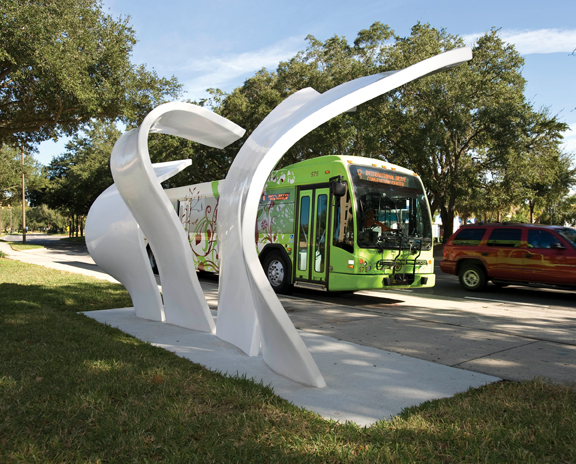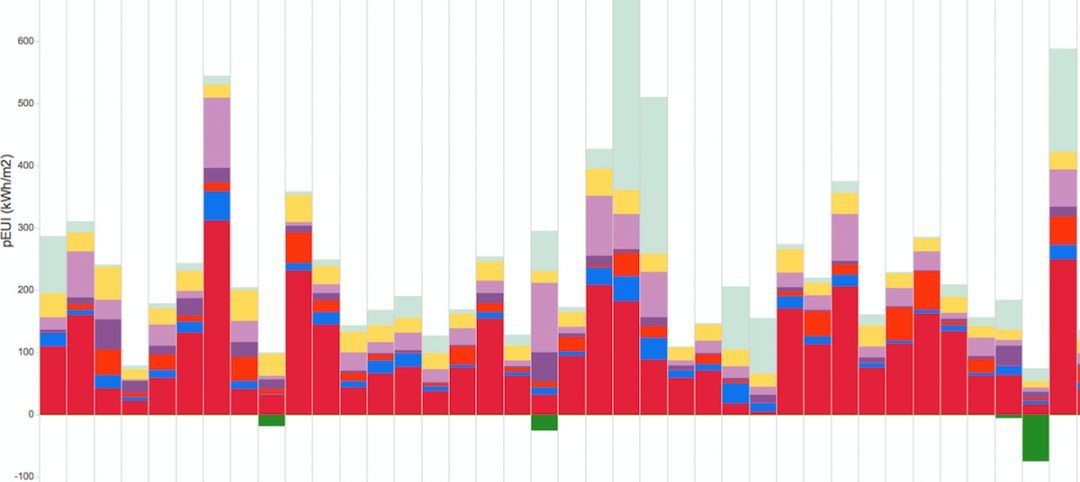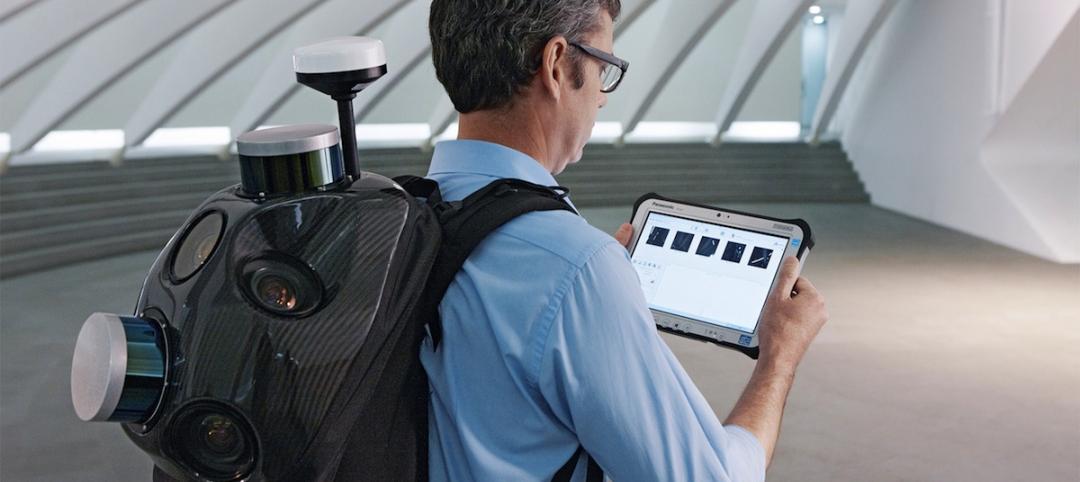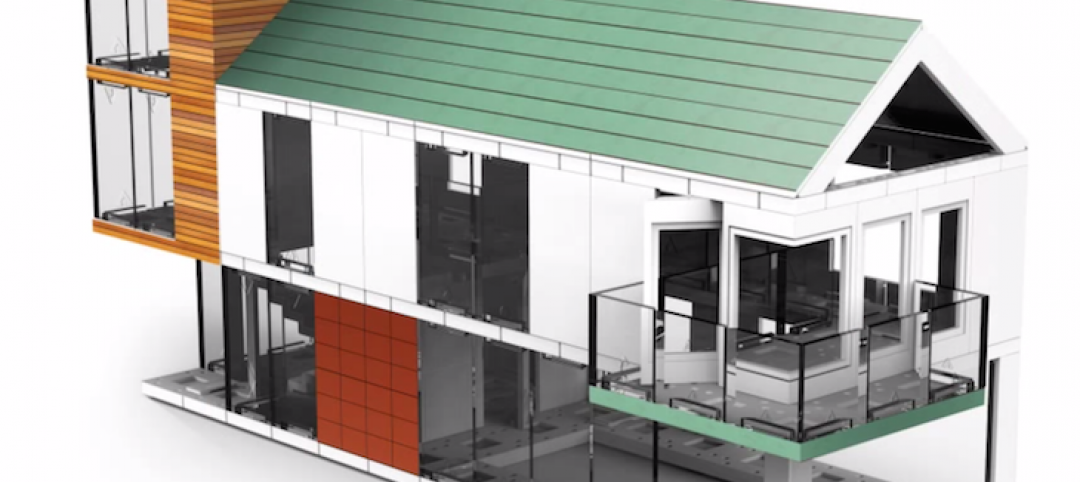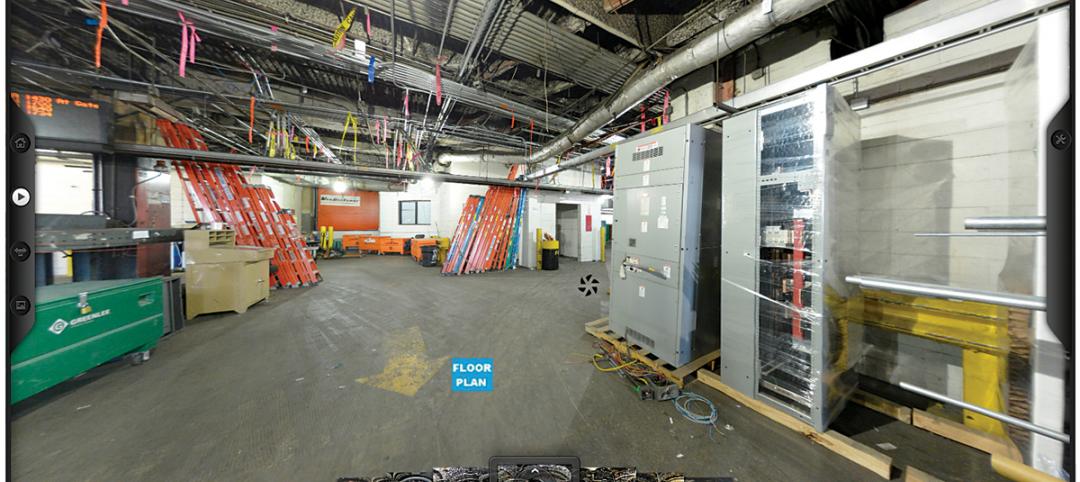ART SHELTERS
In Orlando, sculpture can be found in unexpected places
Public transit users in Orlando, Fla., can now wait for the bus in style. Entech Creative Industries, Walt Geiger Studios, and LYNX (Central Florida Regional Transportation Authority) have adorned four sites along International Drive with “art shelters,” concrete art installations that serve as bus shelters. The art forms are constructed of Entech EG 21 Series Formable Composite Panel. Artist Walt Geiger calls the shelters his “Cascade” collection. The largest includes five structures; the tallest reaches about 12 feet in height. The new shelters bring art to public spaces for bus riders who may never have the opportunity to go to art museums.
 WATER FILLING STATION
WATER FILLING STATION
Tap, tap, tap: Bottle-filling station saves on plastic waste
In 2010, total annual global bottled water consumption measured 8.75 billion gallons; the average American consumed 28.3 gallons of bottled water a year, according to the Bottled Water Association. Elkay’s EZH20 rapid bottle-filling station reduces the waste from manufacturing and disposing of plastic bottles. The filling station can be retrofitted to work with an existing water cooler or installed as a new unit. Its Green Ticker is a built-in visual mechanism that tracks the number of 16-ounce water bottles diverted from landfills. Recent applications: university campuses, airport terminals, and corporate campuses.
 SNAP-AND-GO TILES
SNAP-AND-GO TILES
Modular tiles turn boring office spaces into dynamic work areas
Working within a tight budget with not enough to invest in office décor? Ditto, from 3form, can help enliven any workspace without breaking the bank. Ditto is a modular product that uses cross-shaped pieces that snap together to create customizable partitions, wall features, and art pieces. An online configuration tool helps you design your own creations. Kits come with all the required hardware.
The snap-and-go pieces feature the high design flexibility of 3form’s Varia Ecoresin, a 40% pre-consumer recycled content with color, organic, sheer fabric, and resin properties.
 DECORATIVE GRASS
DECORATIVE GRASS
Move over, chia pet! Now it’s maintenance-free indoor grass
U.K-based media agency Curb has introduced urban greenery that needs no soil and can be used indoors. DesignGrass is 100% natural grass that can be made into any shape, pattern, image, brand, or word, from wallpapers and logos to temporary or permanent displays. It can be installed on indoor surfaces such as walls and ceilings. Once installed, it requires no watering or trimming.
The grass is being used to create green spaces in commercial or residential buildings for architectural or interior design purposes, and could be used for grass furniture, lights, and lampshades, according to Curb.
 OPEN TECHNOLOGY DATA PLATFORM
OPEN TECHNOLOGY DATA PLATFORM
Building management brought to you by the cloud
Occasionally, a more efficient approach to building also is more affordable for owners and operators seeking to achieve better building performance. Panoptix, by Johnson Controls, is an open technology platform that makes it easy for owners to collect and manage data from a wide variety of building systems and other data sources, such as meter and weather data. It provides a suite of cloud-hosted building efficiency applications that work with any building management system currently available to owners. Online and phone support, as well as onsite building and energy services, enables customers to implement operational improvements and energy-saving measures. There’s also an online connected community of peers and experts with whom to share best practices, ideas, and resources.
 SOLAR-POWERED PICNIC TABLE
SOLAR-POWERED PICNIC TABLE
Students can charge their electronic gadgets in the great outdoors of Washington, D.C.
Six students from the Catholic University of America in Washington, D.C., developed a solar-powered picnic table capable of charging laptops, cell phones, tablets, and other electronic devices. The design team included mechanical engineering graduate student Joseph Cochrane and five architecture and sustainable design graduate students: Lindsay Dickes, Michael Doster, Cory Estep, John Lang, and Monica Perez. Escaping the stuffy confines of the university library, students may now use the solar-powered outlets to charge laptops while studying for exams outdoors.
 ELECTRO-CONDUCTIVE WALLBOARD
ELECTRO-CONDUCTIVE WALLBOARD
Low-voltage surface lets you plug in your electronics anywhere in the room
What if, instead of plugging your electronics into an outlet, you could just plug them directly into the wall, anywhere in the room? That’s what the Electro-Conductive Gypsum Wallboard lets you do. A low-voltage surface on a gypsum board makes powering appliances convenient and cost-effective. Electrified wallboards consolidate direct current transformers, while a flexible conductive surface eliminates the need for utility power strips. The wallboard, by Eric Olson of Superficial Studio, utilizes a proprietary conductive thin-film matrix with high-efficiency, nonmagnetic transformers.
 SOLAR CARPORT
SOLAR CARPORT
Charging station can juice up to 13 vehicles a day
The 100 kW-hour solar carport was the result of a partnership between GE Energy Industrial Solutions and Inovateus Solar. The solar carport can generate enough energy to offset the power needed to charge up to 13 vehicles a day using six electric vehicle charging stations. The carport can also generate enough energy to power overhead lighting in the parking lot.
The solar carports are expected to pop up at universities, office buildings, and sports complexes around the country in 2012.
 LIGHTWEIGHT WALLBOARD
LIGHTWEIGHT WALLBOARD
15-30% lighter gypsum boards save lugging on the job
USG’s new Firecode 30 panel, a 5/8-inch board for nonrated and 30-minute fire-rated partitions, is up to 30% lighter than competitive panels. The company’s Firecode X panel is a 5/8-inch gypsum panel that weighs up to 15% less than competitive boards, meets ASTM C1396, and is listed for use in more than 130 UL fire-rated assemblies. According to the manufacturer, the lightweight panels score and snap easily, while also offering a high strength-to-weight ratio and improved sag resistance.
 ELECTRIC PAVING TILES
ELECTRIC PAVING TILES
Produce electricity just by walking on these pavers
Every footstep can be used to generate clean electric power. That’s the premise behind Laurence Kemball-Cook’s paving tiles, which he developed at England’s Loughborough University.
Each tile’s surface is made of recycled truck tires and a base of recycled polymer concrete. A footstep depresses the rubber surface by 1/5 of an inch, and the kinetic energy is then converted into electricity that can be stored, used immediately, or transmitted to a grid. According to Kemball-Cook, the energy generated during the day from about 10 tiles could power a streetlight all night long. The tiles can be used to retrofit existing flooring for both indoor and outdoor applications. BD+C
Related Stories
Green | Jun 8, 2015
Diamond Schmitt Architects creates tool to compare energy use data across building types
The firm's new ecoMetrics tool allows for a comprehensive analysis of data from energy simulation models across a wide range of the company’s building types.
BIM and Information Technology | Jun 5, 2015
Backpack becomes industry first in wearable reality capture
Combining five high-dynamic cameras and a LiDAR profiler, Leica's Pegasus:Backpack creates a 3D view indoors or outdoors for engineering or professional documentation creation.
BIM and Information Technology | Jun 4, 2015
Why reality capture is essential for retrofits
Although we rely upon as-built drawings to help us understand the site for our design, their support is as thin as the paper they are printed on, write CASE's Matthew Nelson and Carrie Schulz.
BIM and Information Technology | Jun 3, 2015
More accurate GPS ready to change the way we shop, interact, and explore
New technology reduces location errors from the size of a car to the size of a nickel—a 100 times increase in accuracy. This is a major technological breakthrough that will affect how we interact with environments, the places we shop, and entertainment venues.
Sponsored | BIM and Information Technology | May 28, 2015
Does BIM Work as a Deliverable?
Sasha Reed sits down with industry professionals at the BIMForum in San Diego to talk about BIM technology.
BIM and Information Technology | May 27, 2015
4 projects honored with AIA TAP Innovation Awards for excellence in BIM and project delivery
Morphosis Architects' Emerson College building in Los Angeles and the University of Delaware’s ISE Lab are among the projects honored by AIA for their use of BIM/VDC tools.
BIM and Information Technology | May 26, 2015
Lego-like model building kit was created by an architect for architects
Arckit, as the system is called, was designed to a 1:48 scale, making it easy to create models accurate to the real-life, physical building projected.
BIM and Information Technology | May 26, 2015
Moore's Law and the future of urban design
SmithGroupJJR's Stephen Conschafter, urban designer and planner, discusses his thoughts on the 50th anniversary of Moore's Law and how technology is transforming urban design.
BIM and Information Technology | May 21, 2015
How AEC firms should approach BIM training
CASE Founding Partner Steve Sanderson talks about the current state of software training in the AEC industry and common pitfalls in AEC training.
BIM and Information Technology | May 13, 2015
5 smart tech trends transforming the job site
RFID labor tracking, 360 cameras, and advanced video tools are among the tech innovations that show promise for the commercial construction industry.


